An Improved RPL Algorithm for Low-Power and Lossy Networks
2023-02-02YananCaoHaoYuan
Yanan Cao ,Hao Yuan
1 Tianjin Key Laboratory of Wireless Mobile Communications and Power Transmission,Tianjin Normal University,Tianjin 300387,China
2 Chinese People’s Liberation Army Unit 61846,Zhuozhou 07250,China
Abstract: The routing protocol for low-power and lossy networks(RPL),standardized by Internet Engineering Task Force(IETF),is mainly designed to use for Low-power and Lossy Networks(LLNs).To solve the problems of several important routing metrics are not evaluated,the optimal path may contain long single hop links,lack of scientific multi-routing metrics evaluation method and mechanism to balance the parent child number (especially the parent with one hop away from root),this paper proposes an improved RPL algorithm for LLN (I-RPL).First of all,we propose the evaluated routing metrics: child number of parent,candidate parent number,hop count,ETX and energy consumption index.Meanwhile,we improve the path ETX calculation method to avoid selecting optimal path containing long single hop links.Then we design a novel lexical method to synthetically evaluate candidate parents.Meanwhile,based on the evaluation results of candidate parents,we design a novel objective function and a new calculation node rank method which can also be used for selecting the optimal path.Finally,evaluation results show that I-RPL outperforms ETXOF and several other improvements in terms of packet delivery ratio,latency,etc.
Keywords: routing protocol;RPL;routing metric;lexical method;objective function
I.INTRODUCTION
Low-power and Lossy Networks (LLNs) [1,2],with the characteristics of complex and harsh communication conditions,is popularly used in urban,industrial,home automation and building automation.The complex and harsh communication conditions mean that the nodes are limited in memory,processing power and energy,and the interconnecting links are featured by low data rates,high packet loss ratio,low bandwidth and instability.The routing protocol for lowpower and lossy networks (RPL) [3-5],standardized by Internet Engineering Task Force(IETF),is mainly designed to use for LLNs.However,most of RPL and its improvements ignore the child number of parent,candidate parent number and other routing metrics which will affect load balance or the optimal path selection.Moreover,the traditional path ETX calculation method may lead to select the optimal path with one or more long single hop links (link in the optimal path has high ETX).This link may be the whole network bottleneck and seriously affect the network performance.Finally,there is also lack of scientific multi-routing metrics evaluation method.Therefore,to solve these problems,an improved RPL algorithm for LLNs(I-RPL)is proposed.The main contributions of this paper are in the following:
• Two evaluated routing metrics are designed:child number of parent(especially the parent with only one hop away from root),candidate parent number are designed.Moreover,hop count,energy consumption and ETX all have important effects on routing decisions,so in order to select the optimal path,all of them should be evaluated.
• Traditional path ETX calculation method is improved: the improved ETX calculation method can effectively avoid selecting the route with long single hop (one or more links with high ETX which may be the bottleneck of the whole network)as the optimal path.
• The new lexical method to synthetically evaluate multi-routing metrics of candidate parents is proposed.
• The novel objective function and new rank calculation method are proposed: the novel objective function can holistically evaluate candidate parents,be effectively applied to rank calculation and the optimal route selection.Rank represents node’s individual position relative to root.
• Simulation evaluations of I-RPL and RPL improvements are implemented.The evaluation results show that I-RPL can effectively improve LLNs performance and outperform RPL and its improvements.
The rest of this paper is structured as follows: Section II explains RPL,its relevant studies and problems.Section III details our contributions:the new proposed I-RPL algorithm.Section IV gives the evaluation results and analysis of I-RPL and other relevant algorithms.Finally,Section V concludes this paper.
II.RELATED WORKS
This section introduces RPL and the problems with its recent improvements.
2.1 Overview of RPL
2.1.1 RPL Control Message
ICMPv6 control messages [6,7] such as DODAG Information Object (DIO),DODAG Information Solicitation (DIS),Destination Advertisement Object(DAO),and Destination Advertisement Object Acknowledgement(DAO-ACK)are mainly used to con-struct network topology for RPL.The main functions of these control messages are listed in Table 1.
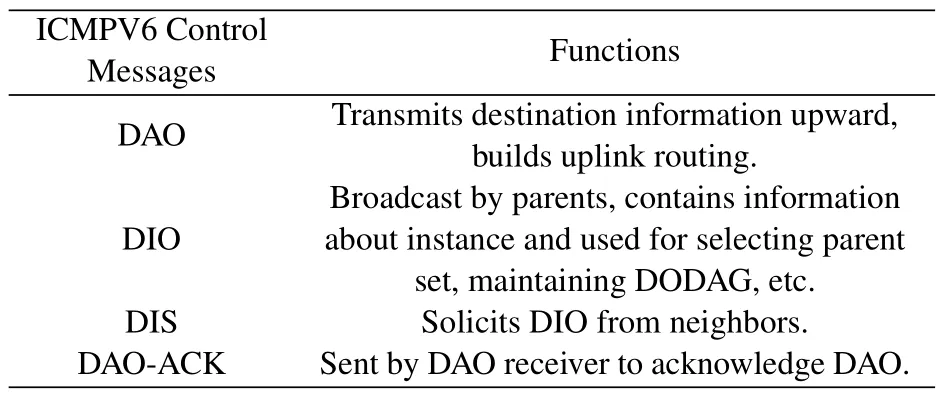
Table 1. ICMPV6 control messages used in RPL.

Table 2. Traffc flow types.
2.1.2 Objective Function
Objective function [8],an important tool of RPL,is used for defining how several routing metrics should be combined and transformed into rank [9].Rank is used for constructing DODAG,selecting the optimal routes,etc.Moreover,objective function can be designed into different forms according to various application requirements.For example,OF0 [10] and MRHOF [11] are designed based on hop count and ETX respectively.They can be applied to different network application scenarios.
2.1.3 Traffic Flow Types
As illustrated in figure 1,RPL supports three basic traffic flows [12]: Point-to-Point (P2P),Point-to-Multipoint (P2MP),and Multipoint-to-Point (MP2P).MP2P is the prime traffic flow.The main features of them are listed in Table 2.
2.1.4 Network Construction
Figure 2 shows an example of RPL network topology.RPL uses Destination-Oriented Directed Acyclic Graph (DODAG) [12] to construct and maintain network topology.DODAG,a directed graph wherein all edges are oriented in such a way that no cycles exist,is built based on RPL control messages and objective function.Figure 3 illustrates the simple construction process of DODAG.The specific construction processes are as follows:
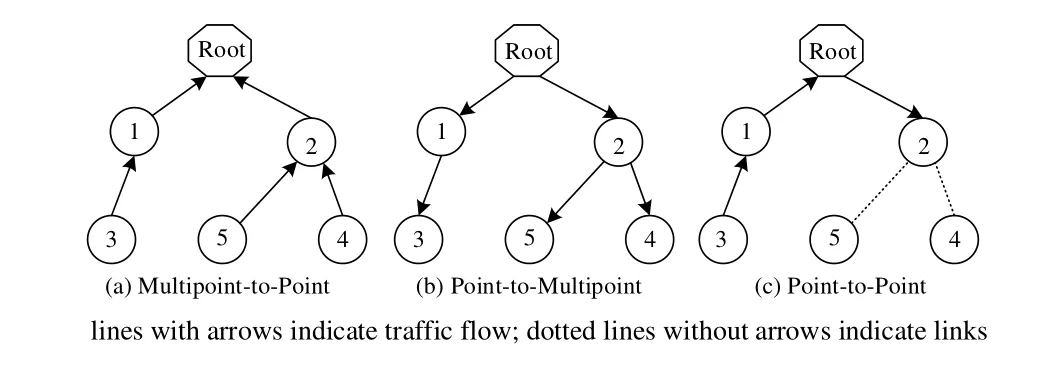
Figure 1. Traffc flow types.
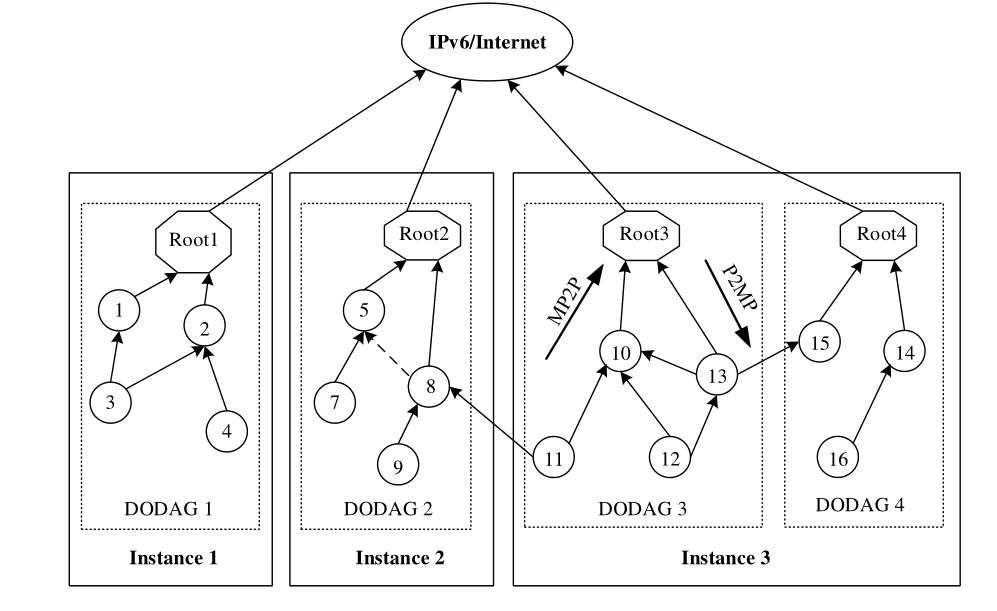
Figure 2. RPL network topology with 4 DODAG in 3 instances.
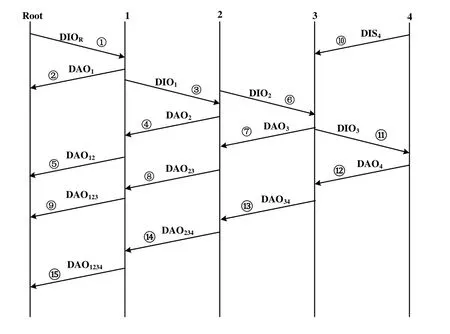
Figure 3. DODAG simple construction process.
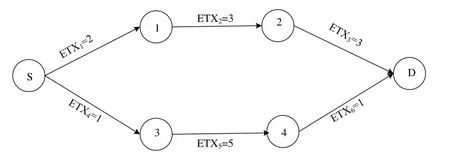
Figure 4. ETX Sample.
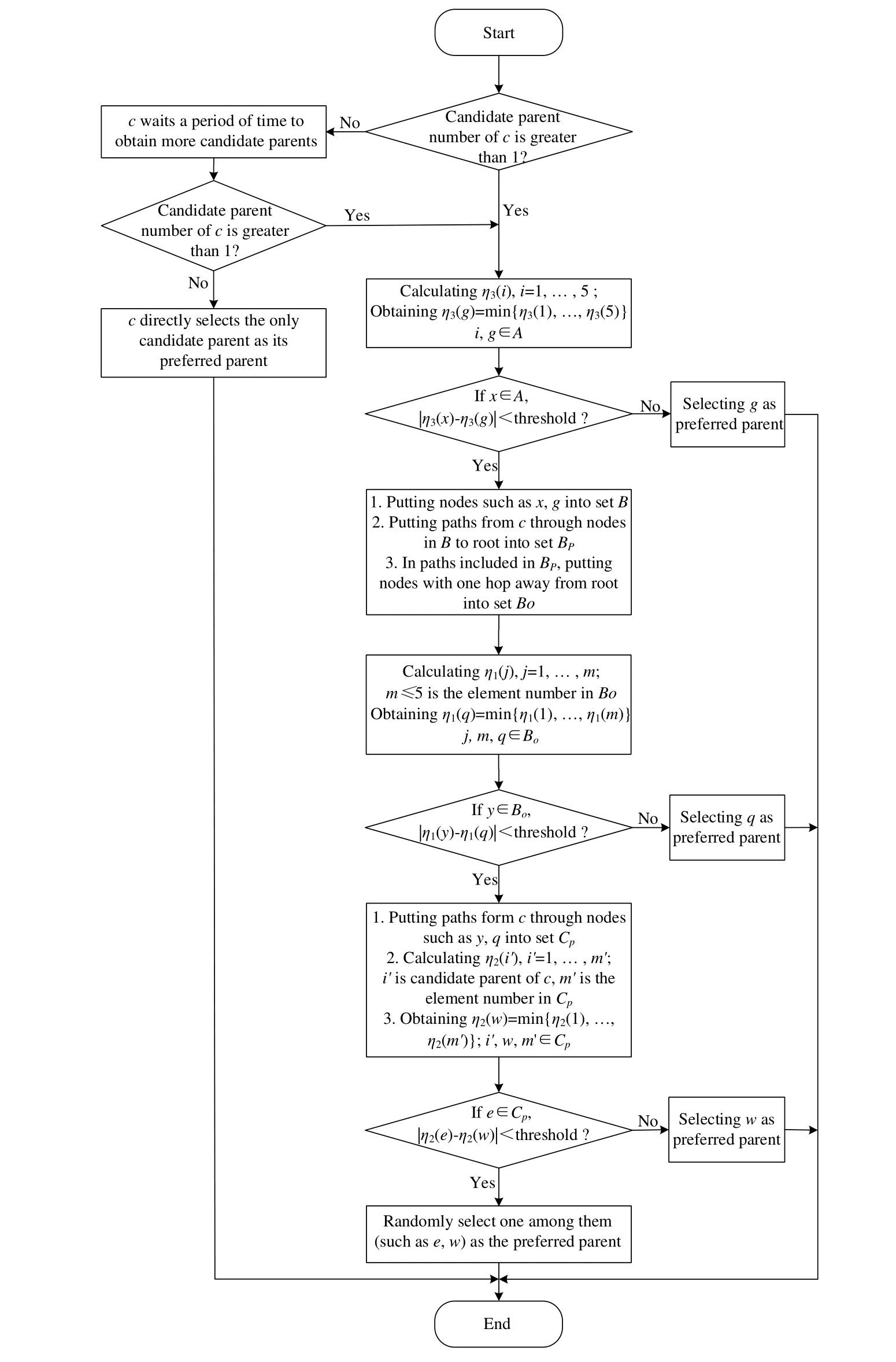
Figure 5. I-RPL novel lexical method flowchart.
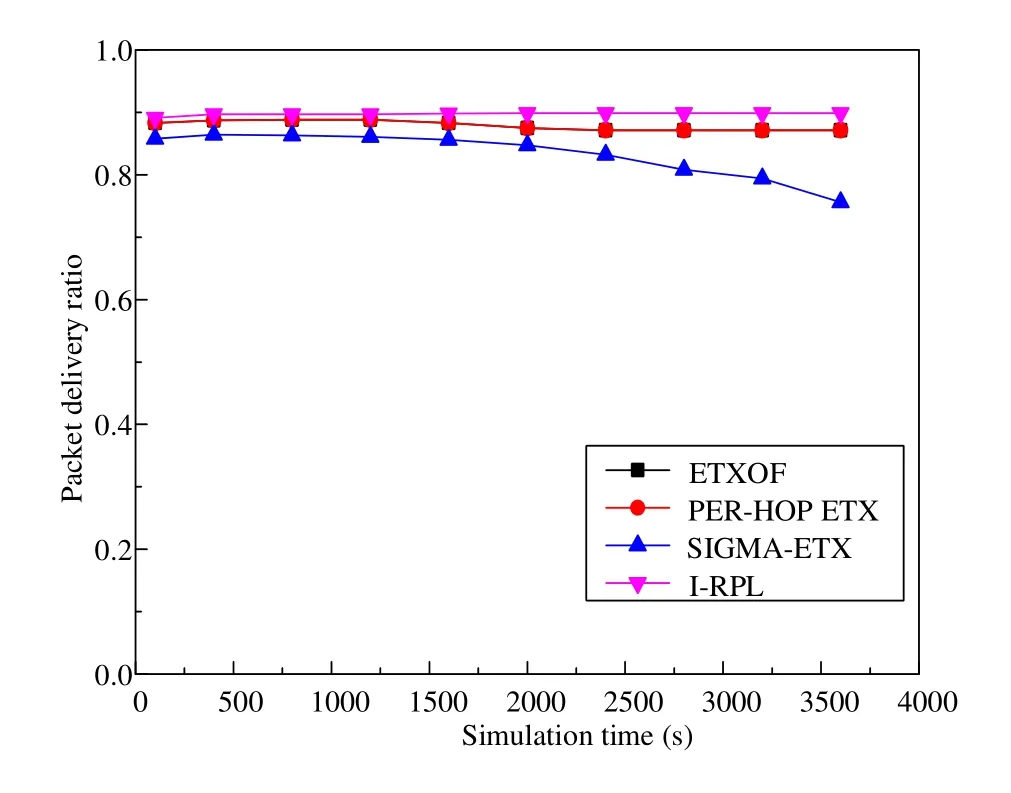
Figure 6. Average packet delivery ratio.
Step 1: Root broadcasts DIO to its neighbors.DIO contains relevant information to construct and maintain DODAG.
Step 2: The neighbor such as node 1 receiving DIO determines whether to select root as its parent according to objective function.If node 1 selects root as its parent,it will unicast DAO to root to build a complete route.
Step 3: Node 1 re-broadcast DIO to its neighbors(node 2).Then,node 2 performs the same operation as node 1.
Step 4: After receiving DAO2from node 2,node 1 unicasts DAO12which contains the updated routing information to root again.
Step 5: Other nodes such as node 3 performs the same operation as abovementioned.
Step 6: If node 4 has not receiving DIO from other nodes within a certain period of time,node 4 will broadcast DIS to solicit DIO form its neighbors(node 3)to join DODAG.
Step 7: After node 4 joining DODAG,node 3 will unicast DAO34which contains the updated routing information to its parent(node 2).Then,node 2 unicasts DAO234 to node 1,and node 1 unicasts DAO1234to root.
Repeat the above steps until the network covers all nodes.
2.2 Problems Description
For RPL,many research works have been done to improve the network performances.But some problems still exist.
2.2.1 Routing Metric Selection
In [6,11],authors only consider ETX of candidate parents.And the candidate parent with the minimum ETX can be selected as the preferred parent.However,the selected optimal path may include long single hop links(one or more links with high ETX which may be the bottleneck of the whole network).In[10],authors only consider hop count of candidate parents.And the candidate parent with the minimum hop count can be selected as the preferred parent.Whereas,both of them only evaluate one routing metric,other key routing metrics are not evaluated,and have no effectively mechanisms to balance the child number of parent(especially the parent with only one hop away from root).
At present,energy consumption and load balancing are the most evaluate routing metrics,such as[13-21].
They combine energy or packet queue length and other routing metrics to select the next hop.However,some of them ignore other key routing metrics.Some have no scientific and reasonable theoretical basis to determine the weight factors of routing metrics in combination objective function,because they usually determined by experts’subjective experiences.So the network performance,the promotion and application of RPL are limited to a certain extent.
2.2.2 The ETX Calculation Method
ETX [22,23],calculated based on equation (1),is the needed number of transmissions(retransmissions)a node expects to successfully transmit and acknowledge one packet.DfandDrare the probability that successfully receiving and acknowledging a packet respectively.The ETX of a path is equal to the sum of the ETX of all the links in that path.

There are many studies about using ETX to select preferred parent.In[24-26],authors proposed to combine ETX and other routing metrics to improve network performance.But there is still no reasonable theoretical basis for determining the weight coefficient of each routing metric and it will increase the computational complexity.Moreover,almost all of the researches calculate the path ETX according to the following method:
The ETX of a path equals to the sum of the link ETX in that path.For example,as shown in figure 4,the ETX of these two candidate paths are as follows:

ETX(path1)>ETX(path2),so path 2 will be selected as the optimal path.But ETX5(the long single hop) between node 3 and 4 in path 2,is too large that it may be the bottleneck of the whole network.Therefore,in many cases,this selection may not be the optimal.
2.2.3 Lack of Scientific Multiple Routing Metrics Evaluation Method
In [27,28],authors propose to construct the objective function by combining multiple routing metrics with linear weighted method.However,it is a difficult problem to decide the weighting coefficients of routing metrics.There is no clear theoretical basis for weight distribution,and most of them are based on subjective experience of experts without considering the actual network operation.In [13,29],authors propose fuzzy logic method to evaluate multiple routing metrics.But the simple fuzzy processing information by fuzzy logic method will reduce control precision and dynamic quality of system.
2.2.4 Lack of Balancing Parent Child Number Method
To date,almost no researches on parent’s child number,especially the parent with only one hop away from root.However,for RPL,the tree-like routing topology,the child number of parent one hop from root is an important routing metric should be considered.The one with too large child number should be avoid selecting as preferred parent.
2.2.5 The Main Problems in Conclusion
In short,as shown in Table 3,RPL and its improvements have the following problems:
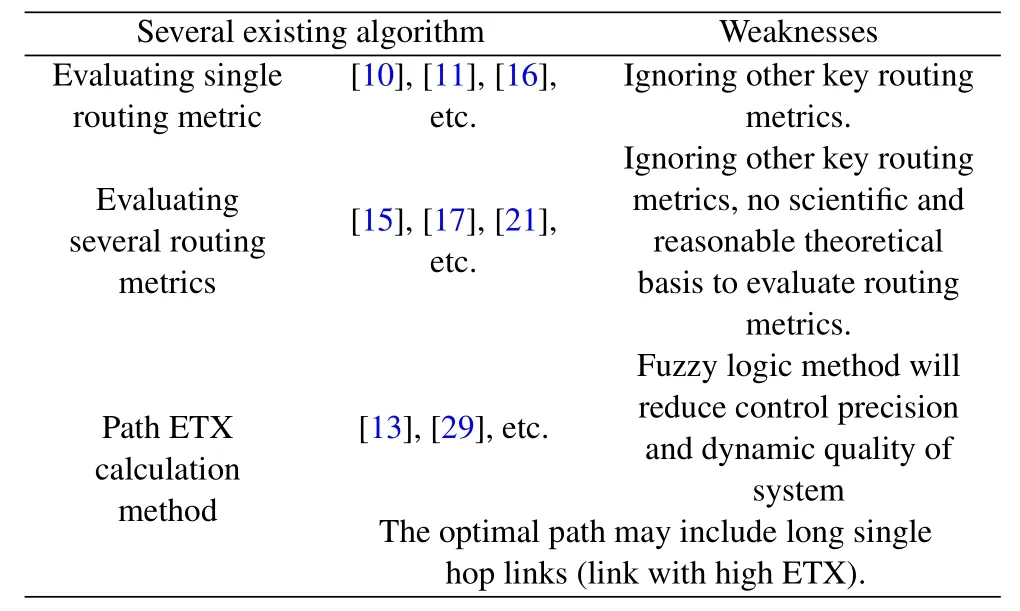
Table 3. Traffc flow types.
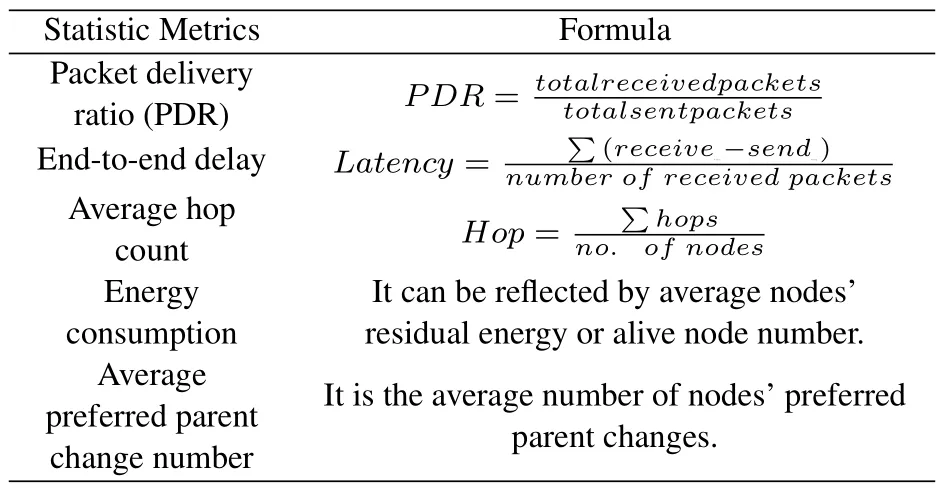
Table 4. The evaluated static metric.
(1) The child number of parent,candidate parent number,ETX all have an important effect on path selection.However,the current improvements of RPL are not evaluating these important routing metrics.
(2) The path ETX calculation method may lead to select the optimal path with one or more long single hop links(link with high ETX).Then this link may be the whole network bottleneck and seriously affect the network performance.
(3) Lack of scientific multi-routing metrics evaluation method and mechanism to balance the parent child number(especially the parent with one hop away from root).Both of them can seriously affect the network performance.
To solve these problems,the improved RPL algorithm for LLN is proposed(I-RPL).Through evaluating the new designed routing metrics;improving the path ETX calculation method and the novel lexicalmethod to synthetically evaluate multiple routing metrics,I-RPL can select the optimal next hop and get notable network performance improvement.
III.I-RPL
This section is dedicated to explain our main contribution which has been simply introduced in section I.
3.1 Outlines of I-RPL
I-RPL,the improved RPL algorithm for LLNs,can be outlined as follows:
(1)Algebraic expression analysis of routing metric.
(2)Proposing several evaluated routing metrics.
(3)Improving the path ETX calculation method.
(4)Designing a new lexical method to synthetically evaluate candidate parents.
(5)Designing a novel objective function and a new calculation node rank method.
In what follows,I-RPL will be detailed according to the above-mentioned outlines.
3.2 Algebraic Expression Analysis of Routing Metric
The quadruplet algebra (P,⊕,f,≤) can be used for representing routing metric.Pis the set of all paths.fis the function which is used for mapping the path to specific value.≤and⊕represent the order relation and paths interconnection operation respectively.So the quadruplet (P,⊕,f,≤) can be named as path value structure.The algebraic expressionp1⊕p2represents the connection of pathp1andp2.≤represents the order relation of path values,wheref(p)≤f(q)means the function value of pathpis smaller than or equal to that of pathq.Through using different metrics off()and≤,the path value structure shows different path features.For example,if hop count is considered,thenf(p)≤f(q) means the hop count of pathpis smaller than or equal to that of pathq,namely pathpis better than pathq.Through algebraic expression of routing metric,the value of each path can be calculated,and these values are ordered.Then,the paths between source and destination are compared,and the optimal path can be selected.
In addition,the algebraic expression of routing metric shall satisfy monotonicity and isotonicity[27].
(1)Monotonicity
Monotonicity means that the value of a path dose not decrease if suffixed or prefixed by another path or link.It can ensure convergence and free of loops for RPL.Mathematically monotonicity can be represented as shown in equation(3).

(2)Isotonicity
Isotonicity means that the order of two paths is preserved if both are prefixed or appended by a third path or link.It can ensure convergence and optimality for RPL.Mathematically isotonicity can be represented as shown in equation(4).

3.3 Routing Metrics Evaluated in I-RPL
This paper designs several representative routing metrics should be evaluated in I-RPL.Given that nodechasncandidate parents (neighbors).There areNnodes in the network.
(1)Child number of parent
Child number of parent is(the parent represents the node with one hop away from root) the node number that the parent is responsible for transmit packets to root.It can be calculated according to the number of received DAOs,but does not include the retransmitted DAOs.Then this child number of parent information will be broadcast to nodes through DIO.As shown in equation (5),mis the number of the parent with one hop away from root.n(j)is the child number of parentj.Therefore,to balance the child number of parent,the candidate path with minimumn(j)can be selected as the optimal path.

(2)Candidate parent number
Candidate parent number can be used to measure the size of candidate parent set.As shown in equation(6),iis a candidate parent ofc.n(i)is the candidate parent number ofi.It can be seen that the larger the candidate parent set is,the larger the selection range ofiselecting its preferred parent,and the greater the chance of selecting high-quality candidate parent as preferred parent,and vice versa.Therefore,candidate parent number can be used to avoid choosing candidate parents whose candidate parent set is small as preferred parent.

(3)ETX
According to the abovementioned path ETX calculation method,the path with long single hop (one or more links in that path have high ETX) may be selected as the optimal path.Therefore,I-RPL proposes the new ETX calculation method which uses the link ETX sum,mean and standard deviation of a path to synthetically evaluate the candidate paths.
(4)Energy Consumption Index(ECI)
Energy consumption index is designed as shown in equation(7).Ei(i)is the initial energy andEc(i)is the current energy of candidate parenti.ECI can be used to avoid selecting high energy consumption candidate parent as preferred parents.ECI will be combined with ETX as shown in equation(12).

(5)Hop count
Hop count is the number of hops between candidate parent and root.This routing metric can be used to avoid selecting the candidate parent with large hop count as preferred parent.Hop count will be used in the calculation process of link ETX mean and standard deviation.So I-RPL does not consider hop count alone.
In general,each routing metric has an important influence on routing decisions.So I-RPL should evaluate all the above proposed routing metrics.Moreover,these routing metrics are monotonicity and isotonicity and can be used as candidate routing metrics to create a composition routing metric.
3.4 The New ETX Calculation Method
Suppose thatETX(i),andσETX(i)are the ETX sum,mean and standard deviation of links in a path which form nodecthrough candidate parentito root.hiis the hop count fromcthroughito root.ETXkis the ETX required of thek-th link.Then,the specific equations for calculatingETX(i),andσETX(i)are as follows:


Then,the specific lexical rules ofETX(i),ETX(i)andσETX(i)are as follows:
Step 1: Calculating ETX(i),andσETX(i)
of pathPiformcthroughito root.
Step 2: ArrangeETX(i)values in ascending order,then the paths with the first five minimumETX(i)values are composed into the alternative path setA.If less than five,then puts all of them into the alternative path setA.
Step 3: The path inAwith the minimumσETX(i),will be selected as the optimal path.For example,supposeσETX(f)is the minimum value in the alternative path set,then the pathPf(the path fromcthrough candidate parentfto root)can be selected as the optimal path.Andfis the preferred parent.
It’s clear to see that comprehensively evaluating ETX sum,mean and standard deviation of links in a path not only ensures link quality,but also avoids selecting the optimal path with large ETX links.To facilitate combining ETX with other routing metrics,normalization is required as shown in equation(11).And the final ETX and energy consumption routing metrics formula used in this paper is shown in equation(12).
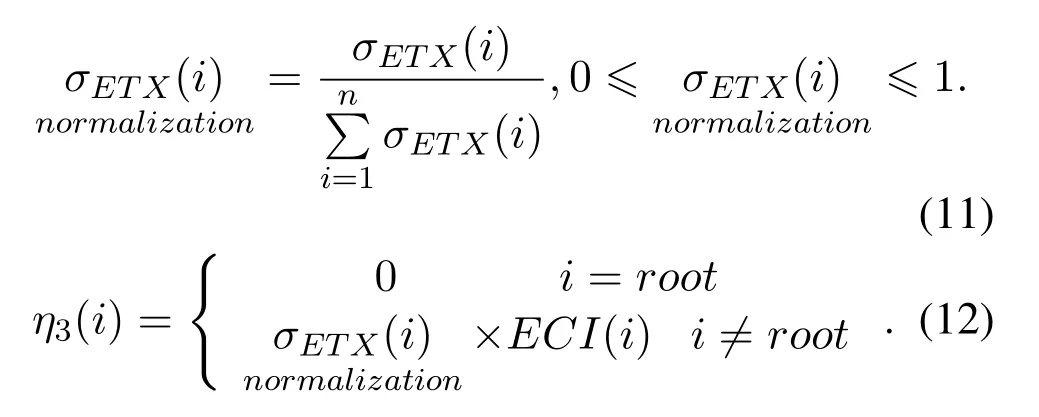
3.5 Novel Lexical Method Used in I-RPL
This section will detail the novel lexical method and the concrete lexical method of I-RPL.
3.5.1 Detailing the Novel Lexical Method
In traditional lexical method[22,30],usually only the first routing metric be evaluated.Since the condition of evaluating the second routing metric is that the first routing metric values of two or more candidate paths are equal to the minimum or maximum value.But this condition can rarely be met.Therefore,in order to comprehensively evaluate candidate parents,we designed the novel lexical method as shown in equation (13).The novel lexical method reduces the condition requirement for evaluating the second routing metric,and increases the possibility of comprehensively evaluating more routing metrics.
In equation (13),P1,P2∈ Pare the candidate paths.fRM1(P1) andfRM1(P2) are the paths values based on the first routing metric,fRM2(P1) andfRM2(P2) are the paths values based on the second routing metric.are the order relation of the metric values setV1and the order relation of the metric values setV2.is the lexical combination.For(fRM1(P1),fRM2(P1))and(fRM1(P2),
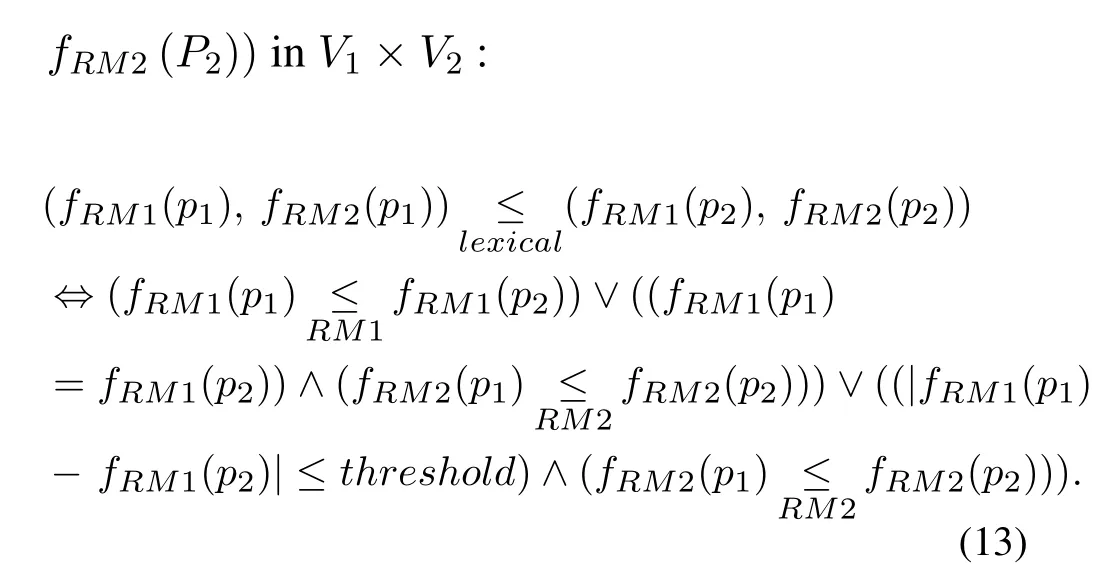
The specific steps of novel lexical metrics combination method can be explained as follows: suppose two routing metrics RM1 and RM2 are considered.Then,according to quadruplet (P,⊕,f,≤),RM1 and RM2 can respectively be represented as
Step 1: Computing RM1 and the path valuesfRM1of each candidate path between source and destination.Then the path with the minimumfRM1will be chosen as the optimal path.If there are two or more paths with the same minimumfRM1or the difference between several paths’fRM1values and the minimumfRM1value is less than the set threshold,then compose these paths into alternative candidate path set 1 and switch to step 2.
Step 2: ComputingfRM2of each path in the candidate path set 1 .Then the one with the minimumfRM2will be chosen as the optimal path.If there are two or more paths with the same minimumfRM2or the difference between several paths’fRM2values and the minimumfRM2value is less than the set threshold,then compose these paths into alternative candidate path set 2 and switch to step 3.
Step 3: Randomly selecting a path from candidate path set 2 as the optimal path.
In this way,the requirement condition for evaluating the second routing metric can be broadened,and the possibility of evaluating the second routing metric can be increased.Moreover,three or more routing metrics also can be combined through the novel lexical method.The operation steps are same as the above steps.And repeat the above steps until all routing metrics have been evaluated.In the following,the specific operations of the novel lexical method used in I-RPL are explained.
3.5.2 Novel Lexical Method Used in I-RPL
Given that nodechasncandidate parents(neighbors).The flowchart of I-RPL novel lexical method is shown in figure 5.And the specific explanation is as follows:
Step 1: Counting candidate parent(neighbor)number ofc,ifconly has one candidate parent (n=1),then switch to step 5.Otherwise,switch to step 2.
Step 2: Calcutingη3(i),i=1,2,···,5.If min{η3(1),···,η3(5)}=η3(g),then selectinggas preferred parent.If min{η3(1),...,η3(5)}=η3(g)=η3(l)=···or| η3(x)-min{η3(1),...,η3(5)} ≤threshold 1,then putg,landxinto alternative candidate path setBand switch to step 3.Herei,g,l,x ∈A.
Step 3: Put the candidate paths fromcthrough alternative candidate parent such asg,landxinBto root into setBP.In paths included inBP,put nodes with one hop away from root into setBo.Then calculateη1(j),j=1,2,···,m.mis the element number ofBo.If min{η1(1),η1(2),···,η2(m)}=η1(q),the path withqis the optimal one.If min{η1(1),···,η1(m)}=η3(q)=η3(r)=···or|η1(y)-min{η1(1),···,η1(m)}≤threshold 2,put paths formcthrough nodes such asy,q,rinBointo setCpand switch to step 4.Here,j,m,q,r,y ∈Bo.
Step 4: Calculateη2(i′),i′=1,···,n′;i′is candidate parent ofc,n′is the element number of setCp.If min{η2(1),···,η2(n′)}=η2(w),wis the optimal next hop.If min{η2(1),η2(2),···,η2(n′)}=η2(w)=η2(z)=···or|η2(e)-min{η2(1),···,η2(n′)} ≤threshold 3 .Then randomly select one among them(such ase,w,z)as the preferred parent.Here,i′,w,e,zn′ ∈Cp.
Step 5: Ifconly has one candidate parent,thencwaits for a period of time to check whether its candidate parent number is greater than or equal to 2.If yes,switch to step 2.Otherwise,cdirectly selects this only candidate parent as its preferred parent without executing the above lexical method.And the rank value ofcis equal to the rank value of this candidate parent plus 1.
It can be seen that I-RPL can synthetically evaluate candidate paths,and select the optimal one.Therefore,the child node number of parent can be balanced,the long single hop problem can be solved,and the scientific multiple routing metrics evaluation method can be settled.In this way,the network performance can significantly be improved.
3.6 Objective Function and Rank Calculation Method
3.6.1 Objective Function(OF)
The objective function can be formulized as equation (14).gis the node with minimumη3(i),i=1,2,···,5.qis the node with minimumη1(j),j=1,2,···,m.wis the node with minimumη2(i′),i′=1,2(g),ETX(q)and ETX(w)are the ETX values of links which are fromcto candidate parentg,qandw.OF(g),OF(q)andOF(w)are objective function values broadcasted in their corresponding DIO messages.In this way,the OF in IRPL can synthetically evaluate candidate parents and select the most suitable one as preferred parent (the next hop).Meanwhile,to which set the selected preferred parent belongs,the corresponding objective function calculation formula will be used.
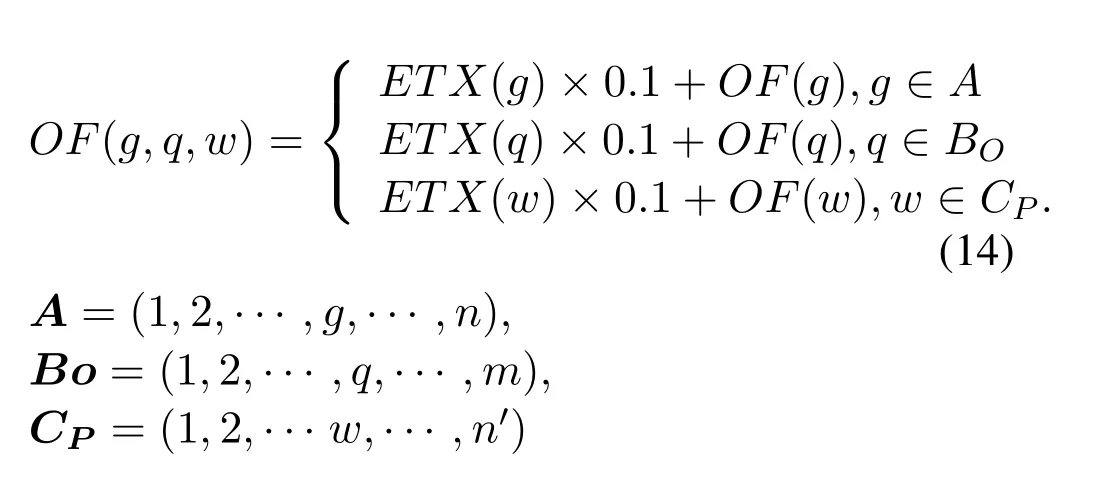
3.6.2 Rank Calculation Method
The rank of node represents its position relative to root.In order to ensure free of loops,rank values do not decrease in the down direction(the direction from root towards leaves).In I-RPL,the rank of root is set 1.0.For other non-root nodes such asc,the rank ofcthrough candidate parenti(Rc(i)) can be calculated according to equation(15).

In equation (15),Rcp(i),advertised by candidate parentithrough DIO,is the rank ofi.OF(i) can be get according to equation(14).
The determination of OF and rank calculation method can further promote the selection of the optimal path,complement with the novel lexical method,and make I-RPL algorithm more systematically and completely.
3.7 Computational Complexity and Convergence Rate Analysis
Computational complexity of I-RPL isO(CN.H).CNis the candidate parent number,His the hop count.I-RPL is executed once when looking for the next hop.The computational complexity ofI-RPL increases with network size increasing.Meanwhile,the computational complexity of these existing algorithms can also be represented asO(CN.H).Therefore,I-RPL does not increase computational complexity compared to RPL and its improvements.The simulation results also prove the effectiveness of I-RPL.
Convergence rate of I-RPL and several RPL improvements can be represented as sup (T(n.H)-1)-1.Tis the network uptime.nandHare the candidate parent number and hop count respectively.It related to network uptime,candidate parent number and other factors.The convergence rate of I-RPL is not lower than RPL improvements.The simulation experiment in section IV will further prove this point.
IV.PERFORMANCE EVALUATION
To quantitatively evaluate and compare the new proposed I-RPL algorithm and several popular improvements of RPL such as ETXOF,PER-HOP ETX [31]and SIGMA-ETX,we carry out a series of experiments by OPNET14.5.
4.1 The Selected Statistic Metrics
This paper selects 5 important statistic metrics as illustrated in Table 4 to comprehensively evaluate and compare the performance of I-RPL and several popular improvements of RPL.
4.2 Simulation Parameters
In the simulation scenario,nodes randomly deployed in 400m×400m network area.The distribution of packets’ arrival is Poisson distribution.Nodes’ initial energy randomly distributes in 0.5J-1.75J.If the residual energy of a node is less than 5%of its initialenergy,the node is considered dead.Other key parameters are illustrated in Table 5.
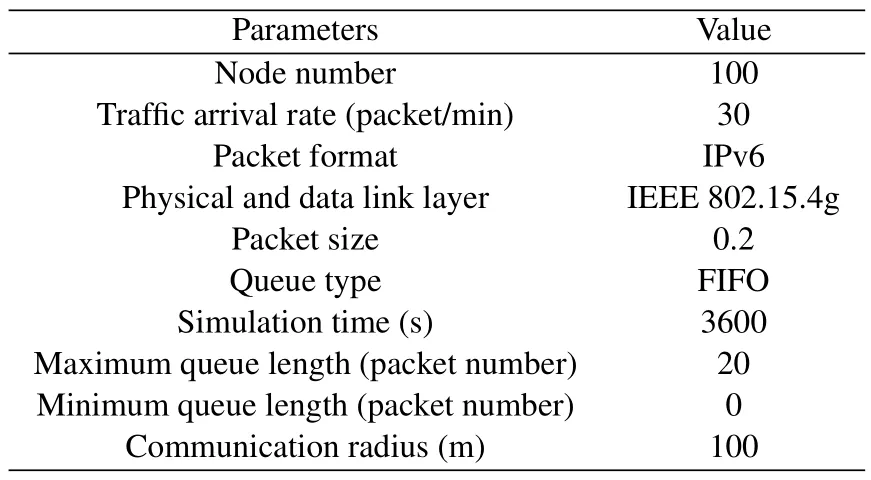
Table 5. Table V Parameters.
4.3 Results and Analysis
(1)Average packet delivery ratio
Figure 6 shows the average packet delivery ratio of I-RPL,ETXOF,PER-HOP ETX and SIGMA-ETX.It shows that the average packet delivery ratio of I-RPL is much higher than that of ETXOF,PERHOP ETX and SIGMA-ETX.Because I-RPL evaluates child number of parent,the ETX sum,mean and standard deviation of links in the path and candidate parent number comprehensively in lexical method.Then,the evaluating single routing metric,long single hop,and no child number of parent balance mechanism are all be solved by I-RPL.Therefore,I-RPL can significantly improve the average packet delivery ratio.
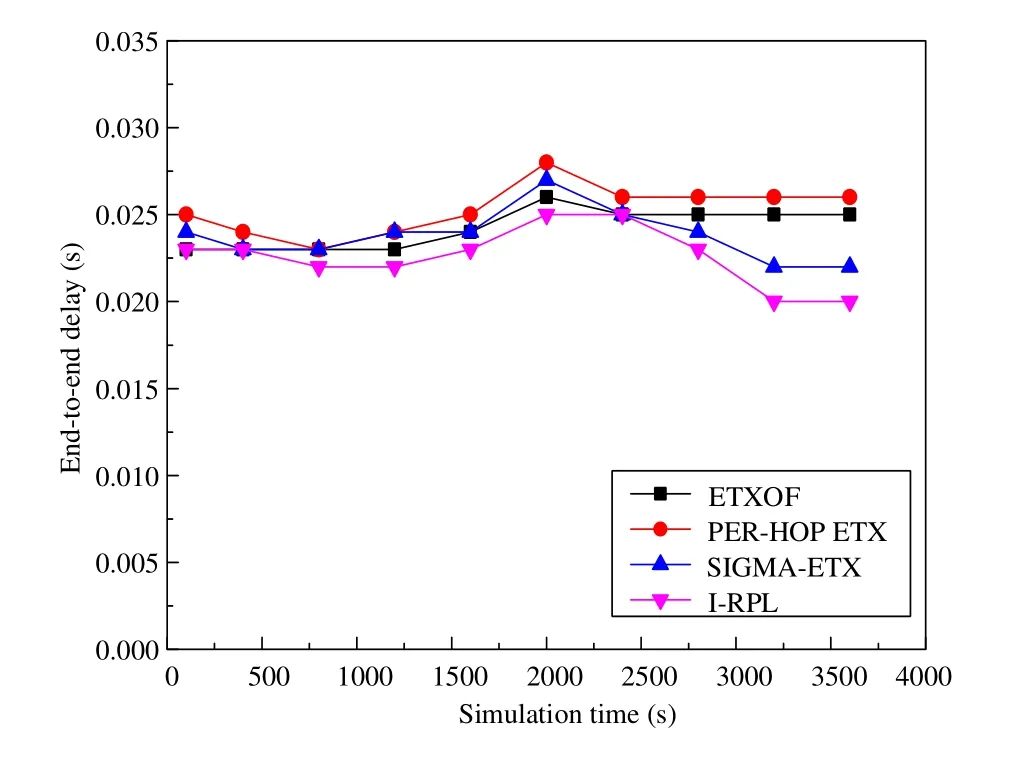
Figure 7. Average end-to-end delay.
(2)Average end-to-end delay
The average end-to-end delay of I-RPL,ETXOF,PER-HOP ETX and SIGMA-ETX are shown in figure 7.It shows that after 2800s,the average endto-end delay of I-RPL,ETXOF,PER-HOP ETX and SIGMA-ETX reach the stable state.And the average end-to-end delay of I-RPL is much lower than that of ETXOF,PER-HOP ETX and SIGMA-ETX.Because I-RPL can select the optimal path without long single hop which impact the real-time performance seriously.Moreover,the candidate parent with high child number cannot be selected as preferred parent in I-RPL.Therefore,I-RPL can significantly improve the realtime property of LLNs through series of new mechanisms.
(3)Average hop count
Figure 8 shows the average hop count of I-RPL,ETXOF,PER-HOP ETX and SIGMA-ETX.It shows that after 2800s,the average hop count of I-RPL,ETXOF,PER-HOP ETX and SIGMA-ETX reach the stable state.And the average hop count of I-RPL is much lower than that of ETXOF,PER-HOP ETX and SIGMA-ETX.I-RPL evaluates hop count when calculatingσETX(i).It is an important evaluates factors for deciding preferred parent.Therefore,I-RPL can reduce the hop count from nodes to root remarkably.
(4)Average preferred parent change number
Average preferred parent change number represents the average number of a node has changed its preferred parents and can be used for indicating network topology stability.Figure 9 illustrates this statistic metric of I-RPL,ETXOF,PER-HOP ETX and SIGMAETX.It’s clear to see that ETXOF and PER-HOP ETX have the highest preferred parent change number which may make the network instability although it can improve network performance to some extent.And the preferred parent change number of I-RPL is the lowest.Therefore,I-RPL can not only improve the network performance significantly,but also ensure the network topology stability.
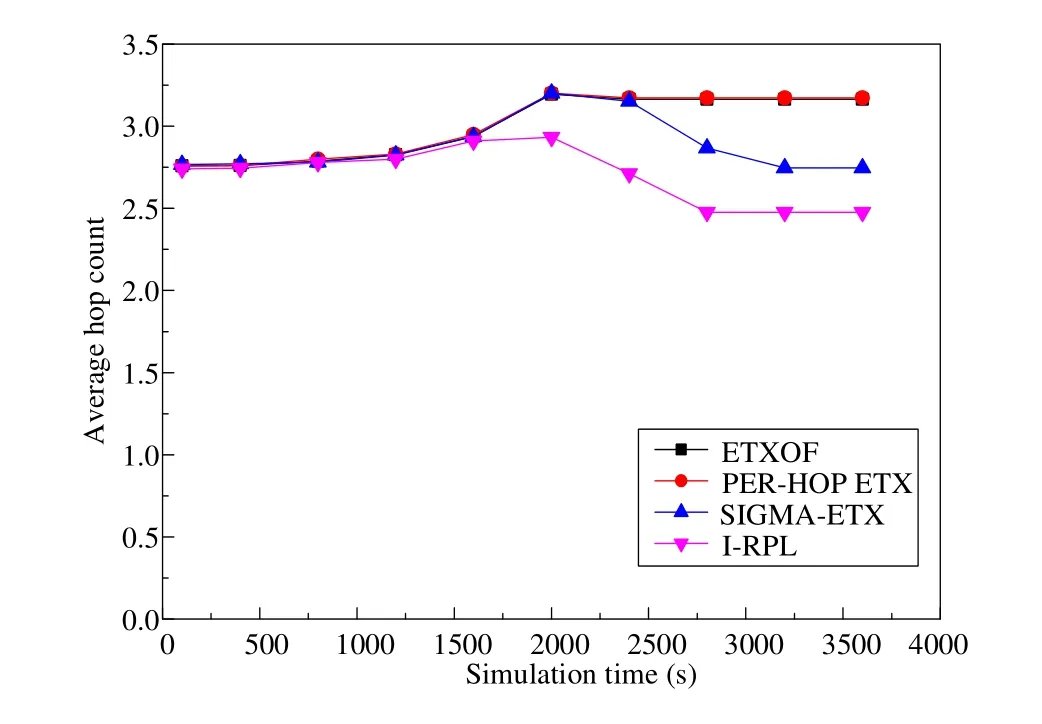
Figure 8. Average hop count.
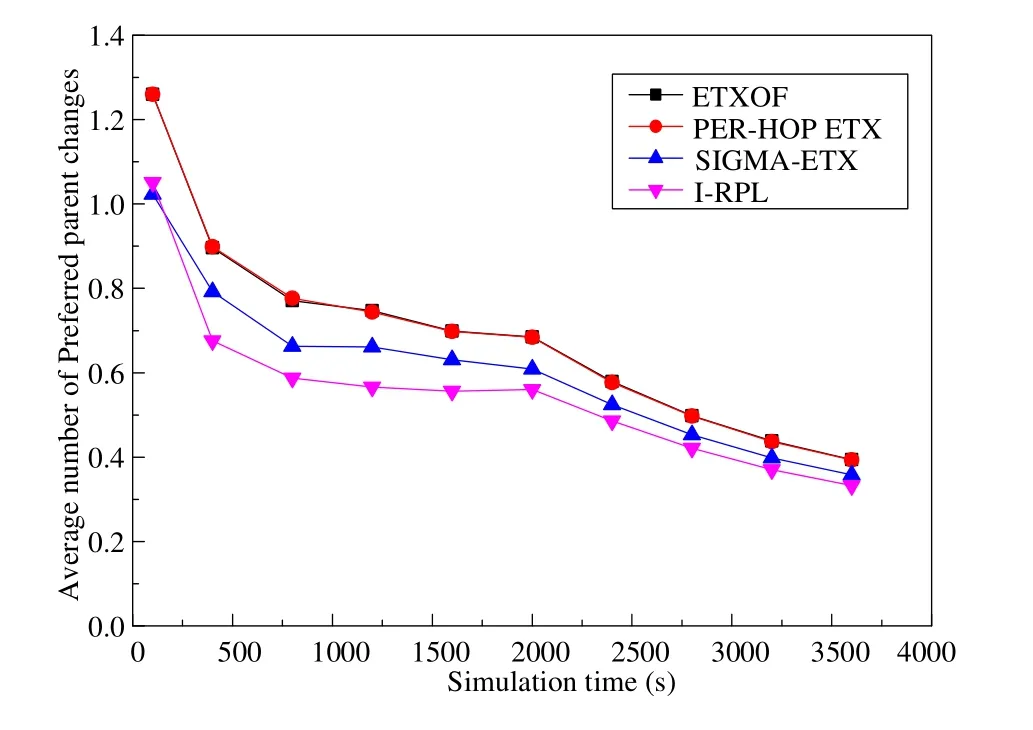
Figure 9. Average number of parent changes.
(5)Energy consumption
Average alive node number and remaining energy can effectively reflect energy consumption.Figure 10 and 11 show these two statistic metrics of I-RPL,ETXOF,PER-HOP ETX and SIGMA-ETX.And these two statistic metrics of I-RPL are superior to ETXOF,PER-HOP ETX and SIGMA-ETX.Therefore,the energy consumption of I-RPL is much lower than that of ETXOF,PER-HOP ETX and SIGMAETX.Because I-RPL avoids selecting optimal path with long single hop and avoids selecting candidate parent with high child number which will save energy consumption significantly.
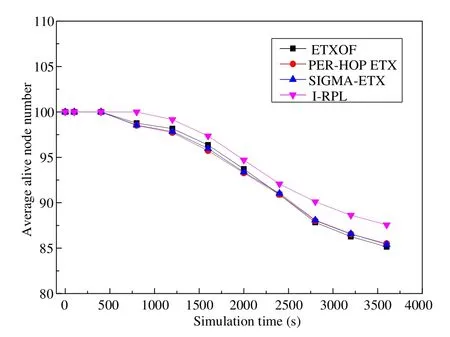
Figure 10. Average alive node number.
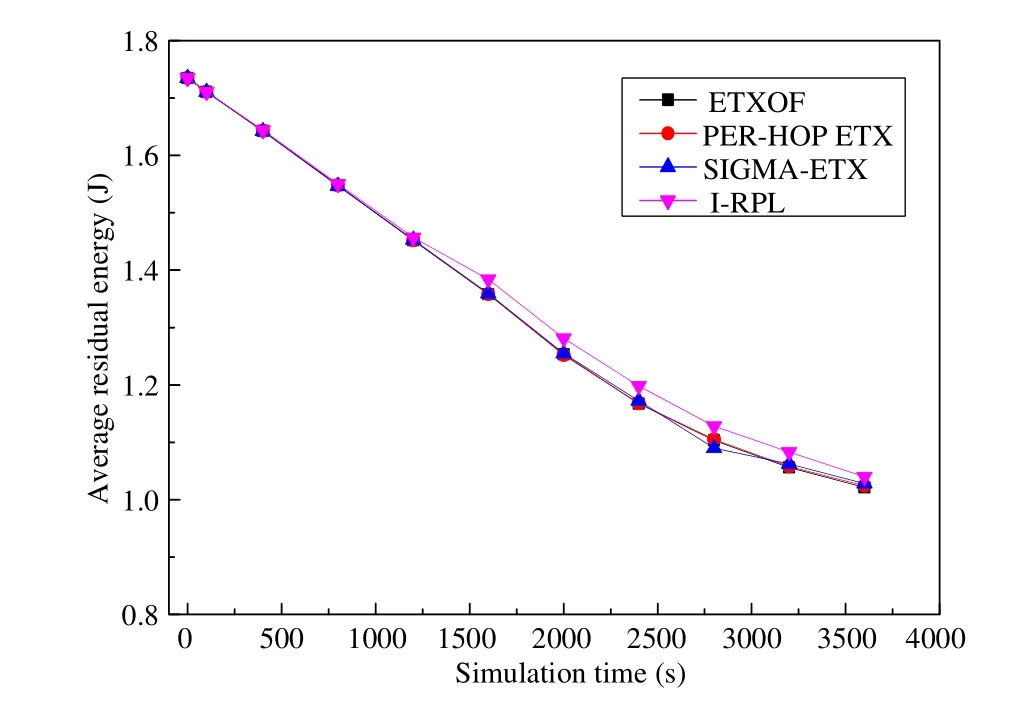
Figure 11. Average residual energy.
V.CONCLUSION
In this paper,I-RPL is proposed.It designs new ETX calculation method to avoid selecting optimal path with long single hop links,synthetically evaluates the child node number of parent,ETX,energy consumption and the candidate parent number of candidate paths to select the optimal path,proposes scientific lexical method to evaluate multiple routing metrics.Then the simulation results and the theoretical analysis show that I-RPL outperforms RPL and its improvements greatly.For future work,we will conduct further research on the routing algorithm in LLNs.Furthermore,energy consumption,6G and HWMP (Hybrid Wireless Mesh Network Protocol) used in LLNs will be studied.
ACKNOWLEDGEMENT
This work is supported by Doctoral Research Project of Tianjin Normal University 52XB2101.
杂志排行
China Communications的其它文章
- Coordinated Planning Transmission Tasks in Heterogeneous Space Networks: A Semi-Distributed Approach
- Secrecy Rate Maximization for 6G Cognitive Satellite-UAV Networks
- Secure Transmission in Cognitive Radio Networks Using Full-Duplex Technique with Outdated CSI
- Computation Rate Maximization in Multi-User Cooperation-Assisted Wireless-Powered Mobile Edge Computing with OFDMA
- A Novel Multi-Granularity Flexible-Grid Switching Optical-Node Architecture
- Model-Free Adaptive Frequency Calibration for Voltage-Controlled Oscillators
